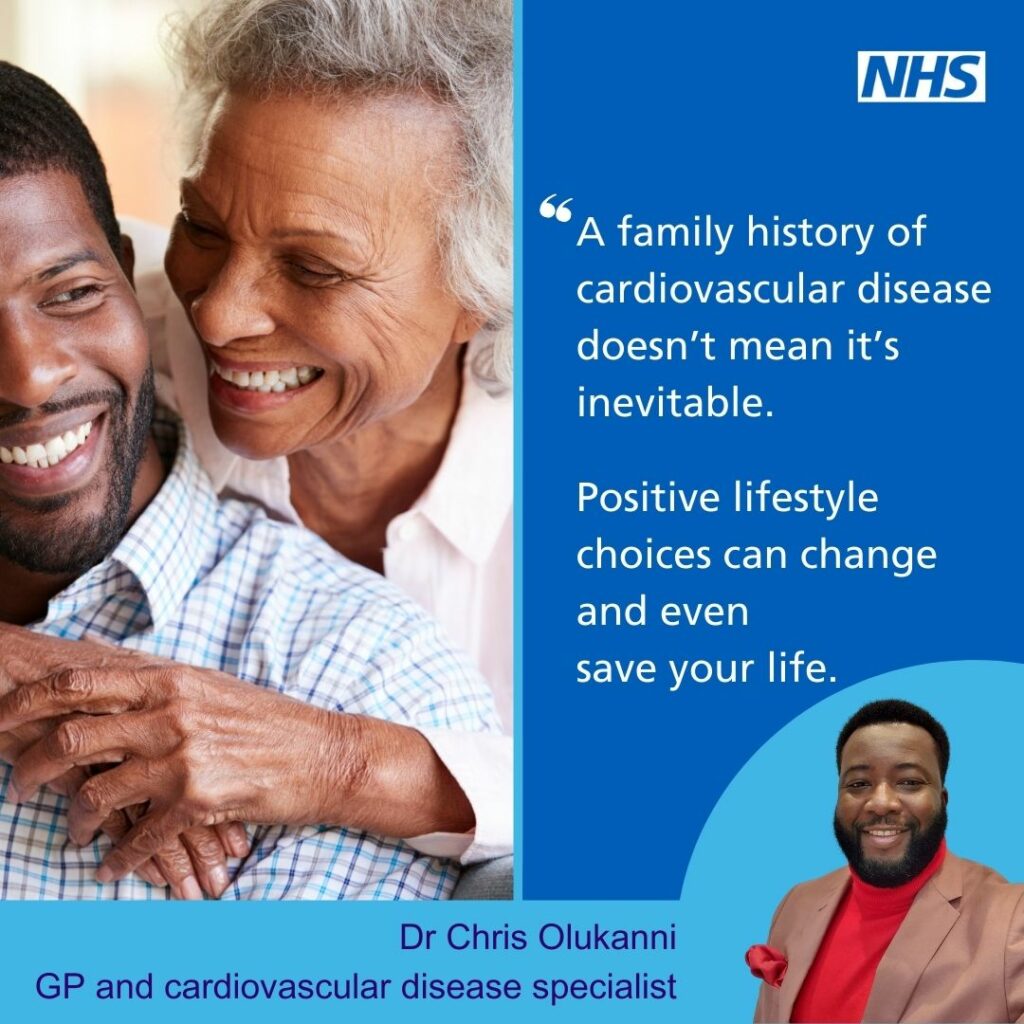
Sarah thought she was young and healthy, until she ended up in an emergency department with chest pains.
“The doctor said, ‘You’ve had a heart attack’, but I just stared at him in disbelief,” she said.
“I knew there was a history of heart disease in my family, but I’d never dreamt it could happen to me.”
“I was 46, I didn’t have high blood pressure, never smoked, and didn’t often drink alcohol. I thought I was in good shape.”
“But I’d assumed all along that because I felt well, I was well.”
“Sarah isn’t alone – it’s easy to think that heart disease, heart attacks or strokes only happen to other people,” says Dr Mohit Mandiratta, a GP in the Midlands. “But they can happen to us too. So, it’s important to understand the different risk factors.”
Dr Chris Olukanni, a GP in Thurrock, Essex, who specialises in cardiovascular health, adds: “We’re here to spell out some of the things you can do to reduce your risks, and where you can get help if you need it.”
What is cardiovascular disease?
Cardiovascular diseases, known as CVD, are conditions that affect the heart or blood vessels, such as stroke, vascular dementia, and heart disease, explains Dr Olukanni.
“Cardiovascular diseases are the leading cause of premature death and disability worldwide. They can develop without symptoms so, like Sarah, your first sign could be a heart attack or stroke.
“Coronary heart disease is a form of cardiovascular disease where the flow of blood to the heart is blocked or reduced. This is usually due to a fatty build-up that narrows our arteries and vessels, a process known as atherosclerosis, which can lead to angina, heart attacks, or stroke.”
What do we mean by risks?
Dr Mandiratta explains our risk of developing CVD is affected by lifestyle-related choices,
“Actions such as smoking, drinking too much alcohol too often, not being active enough, and being overweight all promote the unhealthy fatty build-up in our arteries and vessels. This can cause additional problems like high blood pressure and make it harder for our bodies to work properly.”
“Risk factors also include what we’ve learned about people who are most affected and what they have in common, like their ethnicity, age, or where they live.”
“You are more likely to have CVD if you’re black, Asian or from a minority ethnic background than people of white ethnicity. We are also more likely to have other health conditions that increase our risk, such as kidney disease, high blood pressure and type 2 diabetes.”
“It’s not unusual for people to have multiple risks factors and some of those we can do something about and some we can’t, like our age or ethnicity.”
“Thankfully, if this applies to you, it doesn’t mean that CVD is inevitable. Positive lifestyle choices can reduce your risk of cardiovascular disease. Get advice and help to live well, manage any health conditions you have, and have your free NHS vaccinations, screening, and health checks when invited.”
Do you know the ABCs?
Dr Olukanni explains three health conditions, sometimes called the ABC conditions, are considered high risk for CVD.
“While these conditions are treatable, too many people do not know they have them before they have a major event.”
A: Atrial fibrillation (AF). Causing an irregular heart rate, AF is a major cause of stroke. It’s more common in older people or those with long-term health conditions such as heart disease, high blood pressure or obesity, and heart-valve problems.
Dr Olukanni says: “Sometimes AF has no symptoms, but some people report dizziness, tiredness, a fluttering feeling in their chest or feel like their heart is racing or missing beats. If you experience these symptoms, check your pulse and speak to your GP practice. A normal pulse rate is between 60 and 100 beats a minute.”
B: high blood pressure or hypertension. Affecting around 1 in 4 adults, this is linked to around half of all heart attacks and strokes in the UK. Half of people living with high blood pressure don’t realise, because it usually has no symptoms.
Dr Olukanni adds: “If you have Black or South Asian heritage, you’re more likely to have high blood pressure and at a younger age. A blood pressure test is the only way to check yours.”
C: high cholesterol, which can clog up our arteries, through atherosclerosis.
“High cholesterol is often a result of our lifestyles,” explains Dr Olukanni. “But it can also run in families, linked to an inherited fault passed down in their genes which leads to a condition called familial hypercholesterolaemia, or FH for short, which can cause extremely high levels of cholesterol.”
“The only way to check your cholesterol levels is with a blood or finger prick test”.
Finding the clues in your family history
Sarah, an NHS manager in Yorkshire, hadn’t known she’d inherited a high level of lipoprotein(a), or LP(a), a fatty protein which carries cholesterol in the blood, until after her heart attack. Most people have low levels of it, but some like Sarah are born with higher levels that can block their arteries.
“The clues were in my family history, but I’d not asked anyone about it,” she says. “I remember being invited but I hadn’t had my NHS Health Check either and it wasn’t until the hospital ran tests that I knew what my cholesterol levels were.”
“If I’d understood my risks better, I could have done something about them.”
“Your family’s health history matters” says Dr Mandiratta.
“Patients are often surprised when I ask about their family history, but it helps me understand their risk of serious illnesses. For instance, if a close blood relative has high blood pressure, you’re more likely to have it as well. Or if your father, mother, sister or brother had a heart attack, or a stroke before the age of 60 in men, or 65 in women, you’re also more likely to have a stroke – but it isn’t inevitable”.
“Being alert to your risk of having or developing these conditions provides the opportunity to advise you about prevention and symptoms to look out for, in the hope that we can spot and treat any developing condition before you have any issues or major cardiac (heart) events or a stroke.”
How do I find out my risks?
Dr Olukanni explains that if you have a family history of coronary heart disease or other conditions, your GP practice may want to regularly check your cholesterol or blood pressure. They may also request additional blood tests to look for inherited conditions.
“I advise everyone aged 40 and over to get a free NHS health check every five years, from their GP practice, local council, or some pharmacies. These can spot the early signs of heart disease and stroke, as well as kidney disease, dementia, and type 2 diabetes.”
Many pharmacies also offer free blood pressure checks as well as help to stop smoking and cut back on alcohol. You can find a local pharmacy and check what they offer using the NHS website.
What about screening?
The NHS doesn’t screen for cardiovascular diseases but does provide screening for abdominal aortic aneurysms (AAA) in men. These are swellings in the artery, the aorta, that carries blood from the heart to the tummy (abdomen) and if they burst, cause life-threatening bleeding.
AAA screening is offered once, during the year men turn 65 and involves a quick, painless, ultrasound scan of their abdomen like those offered to women during pregnancy.
Dr Mandiratta explains, “AAA is more common in men over the age of 65, those with high blood pressure or high cholesterol, men who smoke or used to smoke, or have other conditions including coronary heart disease. Screening can spot any swelling in the aorta early on when it is usually treatable.”
“You can reduce your risk of complications, by losing weight, stopping smoking, exercising, and eating healthily.”
Invest in your health.
“I take more time to look after myself these days and take medication every day,” says Sarah. “I’m eating more foods that are good for my heart and put my health first.”
“Having had a heart attack means I’m more at risk of another. Looking after myself now means if something else happens or I need further treatment, I’m well enough to have it and recover quickly.”
“We don’t want people to wait until they have a problem before they come to us for advice,” says Dr Olukanni. “Like Sarah, the biggest difference you can make to your health and wellbeing is with your lifestyle choices and being proactive, even if you already have cardiovascular disease.”
“It can be hard to change habits, but the gains you’ll make could change or even save your life.”
Seven steps to look after your heart

- Be physically active every day. Each week do 150 minutes of moderate activity (to increase your breathing) or 75 minutes of vigorous intensity.
- Maintain a healthy weight with a balanced diet. The free NHS Digital Weight Management Programme offers help to people living with obesity who also have diabetes and/or high blood pressure.
- Don’t smoke. All forms of tobacco (including chewing tobacco and shisha) increase your risk of cancer and cardiovascular disease. Get free advice from your local Stop Smoking Service.
- Reduce your alcohol intake. Long-term heavy drinking can lead to your heart becoming enlarged.
- Get protection – free NHS vaccinations protect those eligible against illnesses, such as rubella and flu, that can place pressure on the heart.
- Stay well – by attending NHS screening, NHS health checks (for people aged 40 – 74) and routine appointments for any long-term illnesses, issues can be better identified and treated quickly.
- Take medication as recommended. Your pharmacist can help you manage your medications and give advice about getting help for prescription costs.